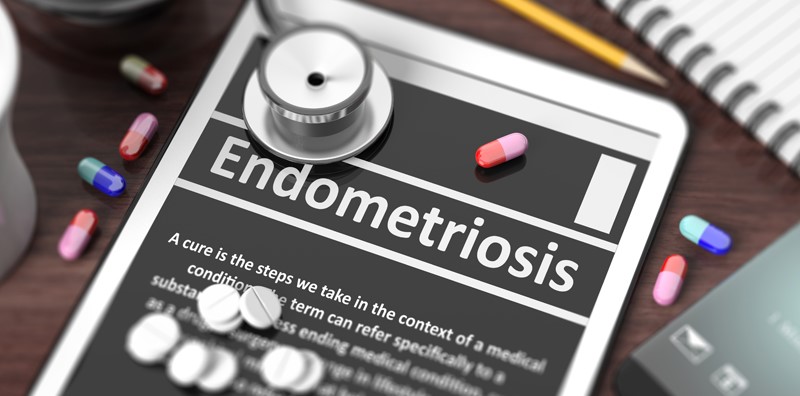
10:16 29th February 2016 | Endometiosis & Infertility
Chronic Disease Reproductive Age Endometrium Ovaries Fallopian Tube Uterus Bladder Vagina Vulva Misplaced Tissue Menstrual Blood Menstrual Cramps Excessive Bleeding Painful Intercourse Painful Urination Painful Bowel Movement Natural Conception Hormone Treatment Surgical Interventions Laproscopy IVF
Endometriosis is a painful, chronic disease that affects 15% of all women of reproductive age and this percentage is reflected in Nigeria. It occurs when tissue, similar to the lining of the uterus (endometrium), is found in organs outside the uterus. These organs may include the ovaries, the fallopian tubes, the ligaments that support the uterus, the bladder, the bowel, the vagina and the vulva. The misplaced tissue can develop into lesions which respond to the menstrual cycle in the same way as the endometrium. Each month the tissue builds up, breaks down, and is shed. Menstrual blood leaves the body through the vagina but the blood and tissue shed from endometrial growths cannot leave the body and cause a variety of problems.
Endometriosis can affect women of all ages who have had children or who have never been pregnant. Some women experience severe menstrual cramps, excessive menstrual bleeding, painful intercourse and pain when urinating or having bowel movements,during periods, while for others the only symptom is infertility. Endometriosis can be found in up to fifty percent of infertile women and there is a strong association between endometriosis and infertility.
Endometriosis inhibits natural conception for several reasons. Excess tissue growing in the uterus can make it harder for an embryo to attach to the uterine wall. Endometrial cells attached to the ovaries or fallopian tubes can alter normal ovulation or cause the fallopian tubes to become blocked. The excess tissues bleed during menstruation and can cause obstructive scar tissue when adhered to the uterus, the fallopian tubes, the ovaries and other abdominal organs. Treatment options include hormone treatment and surgical intervention but IVF is the most effective solution for women who want to have a family.
Hormonal treatment can treat the symptoms of endometriosis but it is not a cure. It will prevent ovulation and help to slow the growth and activity of both the endometrium and existing endometrial lesions but it will not make existing adhesions go away. Oral contraceptives, birth control pills, Gonadotropin-releasing hormone (GnRH) are generally prescribed and patients with mild endometriosis may well become pregnant after this treatment.
Surgical intervention is used to alleviate pain by removing the endometriosis, dividing adhesions and removing cysts. Conservative surgery, which aims to remove or destroy the deposits of endometriosis, is usually done via a laparoscopy (keyhole surgery) and can improve fertility in women who have mild or minimal endometriosis. A more complex option involves surgery on affected organs such as the bowel or the bladder. Radical surgery involves the removal of the womb (hysterectomy) or removal of the ovaries (oophorectomy) and is only proposed to women who have not responded to hormone treatments or conservative surgery and who are not planning to start a family.
IVF is the best possible solution for women affected by infertility-related endometrisis who want to have a baby. Couples diagnosed with endometriosis have high success rates with In vitro fertilisation (IVF) and frozen embryo transfer(FET). Success rates vary according to the woman’s age but IVF and FET are the most effective treatments for moderate or severe cases of endometriosis, particularly when hormone therapy or surgery have failed to restore fertility.
In the normal IVF process, the woman’s eggs are retrieved and fertilised by her partner’s sperm in the laboratory. The resulting embryos are transferred into the uterus. Studies show that the transfer of frozen embryos (FET) has a higher rate of success than the transfer of fresh embryos, when the woman has endometriosis. With FET the woman’s eggs are collected, fertilised in the laboratory and the subsequent embryos frozen in a process called cryopreservation. When the woman is ready to conceive, the embryos are thawed and implanted into the womb. The process is completely safe-and offers a high rate of success
Endometriosis does not affect the development of the foetus and most women with endometriosis have healthy pregnancies and healthy babies. Endometriosis can viewed as a stumbling block to natural conception, but with the proper treatment,successful pregnancies can be achieved. If you have the symptoms described above, please speak to one of our fertility specialists and discuss what treatment is best likely to help you. Call 01 631 0092 or email enquiries@thebridgeclinic.com.
Search by condition, treatment or keyword and conveniently browse our informative articles
Book an appointment online or search for a clinic close to you.
Book an Appointment